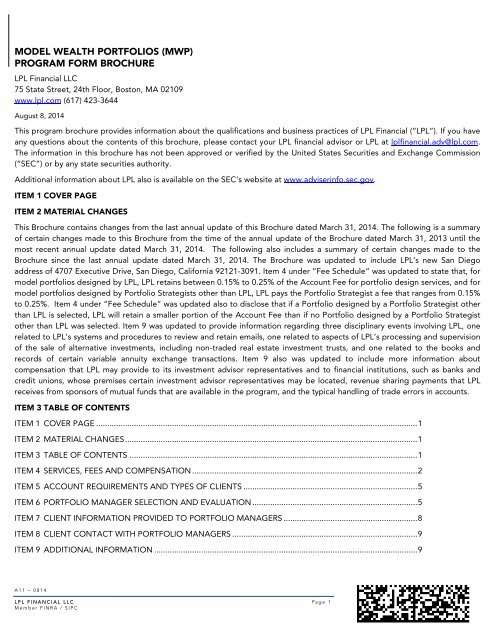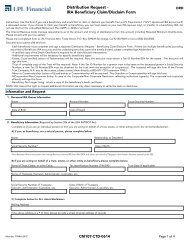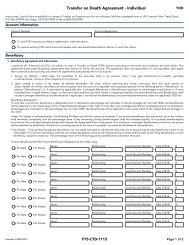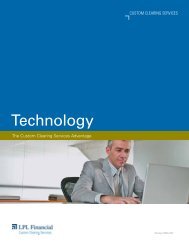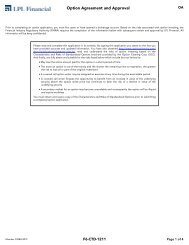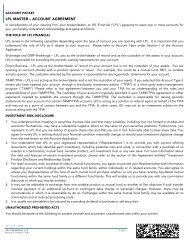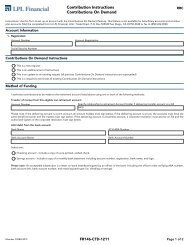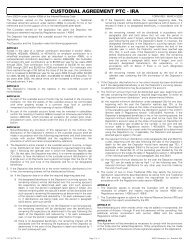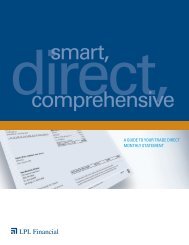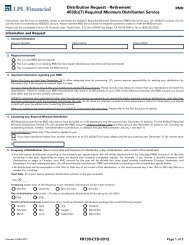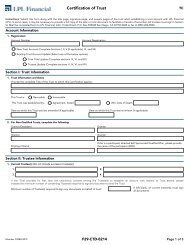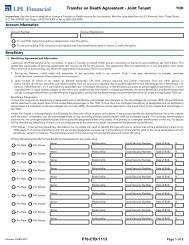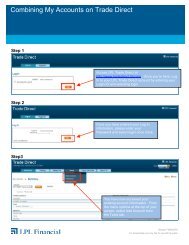Model Wealth Portfolios (MWP) - LPL Financial
Model Wealth Portfolios (MWP) - LPL Financial
Model Wealth Portfolios (MWP) - LPL Financial
Create successful ePaper yourself
Turn your PDF publications into a flip-book with our unique Google optimized e-Paper software.
MODEL WEALTH PORTFOLIOS (<strong>MWP</strong>)<br />
PROGRAM FORM BROCHURE<br />
<strong>LPL</strong> <strong>Financial</strong> LLC<br />
75 State Street, 24th Floor, Boston, MA 02109<br />
www.lpl.com (617) 423-3644<br />
August 8, 2014<br />
This program brochure provides information about the qualifications and business practices of <strong>LPL</strong> <strong>Financial</strong> (“<strong>LPL</strong>”). If you have<br />
any questions about the contents of this brochure, please contact your <strong>LPL</strong> financial advisor or <strong>LPL</strong> at lplfinancial.adv@lpl.com.<br />
The information in this brochure has not been approved or verified by the United States Securities and Exchange Commission<br />
(“SEC”) or by any state securities authority.<br />
Additional information about <strong>LPL</strong> also is available on the SEC’s website at www.adviserinfo.sec.gov.<br />
ITEM 1 COVER PAGE<br />
ITEM 2 MATERIAL CHANGES<br />
This Brochure contains changes from the last annual update of this Brochure dated March 31, 2014. The following is a summary<br />
of certain changes made to this Brochure from the time of the annual update of the Brochure dated March 31, 2013 until the<br />
most recent annual update dated March 31, 2014. The following also includes a summary of certain changes made to the<br />
Brochure since the last annual update dated March 31, 2014. The Brochure was updated to include <strong>LPL</strong>’s new San Diego<br />
address of 4707 Executive Drive, San Diego, California 92121-3091. Item 4 under “Fee Schedule” was updated to state that, for<br />
model portfolios designed by <strong>LPL</strong>, <strong>LPL</strong> retains between 0.15% to 0.25% of the Account Fee for portfolio design services, and for<br />
model portfolios designed by Portfolio Strategists other than <strong>LPL</strong>, <strong>LPL</strong> pays the Portfolio Strategist a fee that ranges from 0.15%<br />
to 0.25%. Item 4 under “Fee Schedule” was updated also to disclose that if a Portfolio designed by a Portfolio Strategist other<br />
than <strong>LPL</strong> is selected, <strong>LPL</strong> will retain a smaller portion of the Account Fee than if no Portfolio designed by a Portfolio Strategist<br />
other than <strong>LPL</strong> was selected. Item 9 was updated to provide information regarding three disciplinary events involving <strong>LPL</strong>, one<br />
related to <strong>LPL</strong>’s systems and procedures to review and retain emails, one related to aspects of <strong>LPL</strong>’s processing and supervision<br />
of the sale of alternative investments, including non-traded real estate investment trusts, and one related to the books and<br />
records of certain variable annuity exchange transactions. Item 9 also was updated to include more information about<br />
compensation that <strong>LPL</strong> may provide to its investment advisor representatives and to financial institutions, such as banks and<br />
credit unions, whose premises certain investment advisor representatives may be located, revenue sharing payments that <strong>LPL</strong><br />
receives from sponsors of mutual funds that are available in the program, and the typical handling of trade errors in accounts.<br />
ITEM 3 TABLE OF CONTENTS<br />
ITEM 1 COVER PAGE ................................................................................................................................................ 1<br />
ITEM 2 MATERIAL CHANGES ................................................................................................................................... 1<br />
ITEM 3 TABLE OF CONTENTS ................................................................................................................................. 1<br />
ITEM 4 SERVICES, FEES AND COMPENSATION ..................................................................................................... 2<br />
ITEM 5 ACCOUNT REQUIREMENTS AND TYPES OF CLIENTS .............................................................................. 5<br />
ITEM 6 PORTFOLIO MANAGER SELECTION AND EVALUATION .......................................................................... 5<br />
ITEM 7 CLIENT INFORMATION PROVIDED TO PORTFOLIO MANAGERS ............................................................ 8<br />
ITEM 8 CLIENT CONTACT WITH PORTFOLIO MANAGERS ................................................................................... 9<br />
ITEM 9 ADDITIONAL INFORMATION ...................................................................................................................... 9<br />
A11 – 0814<br />
<strong>LPL</strong> FINANCIAL LLC Page 1<br />
Member FINRA / SIPC
MODEL WEALTH PORTFOLIOS - PROGRAM FORM BROCHURE<br />
ITEM 4 SERVICES, FEES AND COMPENSATION<br />
Services<br />
<strong>LPL</strong> offers various types of advisory services and programs, including wrap fee programs, mutual fund asset allocation programs,<br />
advisory programs offered by third party investment advisor firms, financial planning services, and retirement plan consulting<br />
services. This Brochure provides a description of the advisory services offered under <strong>LPL</strong>’s <strong>Model</strong> <strong>Wealth</strong> <strong>Portfolios</strong> (“<strong>MWP</strong>”)<br />
program. For more information about <strong>LPL</strong>’s advisory services and programs other than <strong>MWP</strong>, please contact your <strong>LPL</strong><br />
investment advisor representative (“IAR”) for a copy of a similar brochure that describes such service or program or go to<br />
www.adviserinfo.sec.gov.<br />
<strong>LPL</strong> is also a broker-dealer registered with the <strong>Financial</strong> Industry Regulatory Authority (“FINRA”), and an IAR also may be<br />
registered with <strong>LPL</strong> as a broker-dealer registered representative. Therefore, an IAR may be able to offer a client both<br />
investment advisory and brokerage services. Before engaging with an IAR, clients should take time to consider the differences<br />
between an advisory relationship and a brokerage relationship to determine which type of service best serves the client’s<br />
investment needs and goals. Clients should speak to the IAR to understand the different types of services available through<br />
<strong>LPL</strong>. Clients also should refer to the informational brochure on www.lpl.com titled “Working with an <strong>LPL</strong> <strong>Financial</strong> Advisor: The<br />
Choice Between Advisory Services and Brokerage Services.”<br />
The <strong>MWP</strong> program is a professionally managed mutual fund and exchange-traded fund (“ETF”) asset allocation program in<br />
which <strong>LPL</strong> and its investment advisor representatives (“IARs”) provide ongoing investment advice and management. The IAR<br />
obtains the necessary financial data from the client, assists the client in determining the suitability of the program and assists the<br />
client in setting an appropriate investment objective. The IAR selects a model portfolio of funds (“Portfolio”) designed by <strong>LPL</strong>’s<br />
Research Department or a third-party investment strategist (“Portfolio Strategist”) consistent with the client’s stated investment<br />
objective. The IAR provides ongoing advice on the selection or replacement of a Portfolio based on the client’s individual<br />
needs. The IAR may choose more than one Portfolio to be managed within a single <strong>MWP</strong> account. The <strong>MWP</strong> program also<br />
permits clients to select a third party investment advisor firm associated with an <strong>LPL</strong> registered representative, in lieu of an IAR,<br />
to provide the advisory services described in this brochure.<br />
The Portfolio Strategist is responsible for selecting the mutual funds and/or ETFs within a Portfolio and for making changes to<br />
the funds selected. <strong>LPL</strong> has discretion to buy and sell securities in the account according to the Portfolio selected and liquidate<br />
previously purchased securities that are transferred into the account. Exchange-traded notes (“ETN”) and closed-end funds may<br />
also be purchased in an account. The client authorizes <strong>LPL</strong> and the IAR to have discretion by executing the Account Agreement<br />
and Application.<br />
Except for <strong>LPL</strong> and Fortigent, LLC (“Fortigent”), the Portfolio Strategists are independent investment advisor firms. Portfolio<br />
Strategists provide <strong>LPL</strong> on an ongoing basis with a Portfolio that includes recommended asset allocations and funds. <strong>LPL</strong> enters<br />
into an agreement with the Portfolio Strategist for these Portfolio services. Except for <strong>LPL</strong>, Portfolio Strategist does not have<br />
discretion from the client to implement the Portfolio and does not provide individualized investment advice to specific program<br />
clients. In certain cases, a Portfolio may consist only of mutual funds and/or ETFs within the same fund family or within affiliated<br />
fund families. In such a Portfolio, the Portfolio Strategist will select only those funds within the fund family or affiliated fund families.<br />
<strong>LPL</strong> acts as the overlay portfolio manager (“OPM”) in coordinating the trades in the account and performing tax harvesting<br />
services. <strong>LPL</strong> as the OPM is responsible for rebalancing accounts in accordance with the allocations in the Portfolio. <strong>LPL</strong> will<br />
review an account to determine if rebalancing is appropriate based on the frequency selected by the client at account opening<br />
or as altered by the client or the IAR from time to time. The choices for frequency of rebalancing review are quarterly (four times<br />
per year), semiannually (two times per year) or annually (once per year). At each rebalancing review date, <strong>LPL</strong> will rebalance the<br />
account only if at least one fund position is outside a pre-determined range, subject to a minimum transaction amount<br />
established by <strong>LPL</strong> in its discretion. In addition, <strong>LPL</strong> will review an account for rebalancing in the event that the Portfolio<br />
Strategist changes the allocation targets.<br />
A11 – 0814<br />
<strong>LPL</strong> FINANCIAL LLC Page 2<br />
Member FINRA / SIPC
MODEL WEALTH PORTFOLIOS - PROGRAM FORM BROCHURE<br />
<strong>LPL</strong>, at the request of the client or IAR, performs tax harvesting. In such case, proceeds of tax-related transactions may be held<br />
in cash until appropriate wash sale periods have expired. Once the wash sale period has expired, the related proceeds will be<br />
invested according to the current targeted allocation for the Portfolio. In addition, <strong>LPL</strong> may delay placing rebalancing<br />
transactions for non-retirement accounts by a number of days, to be determined by <strong>LPL</strong>, in an attempt to limit short-term tax<br />
treatment for any position being sold. Under certain conditions, <strong>LPL</strong> also will accommodate requests for all or a portion of an<br />
account to remain allocated to cash for a period of time. Such customized requests, liquidation requests in connection with<br />
withdrawals, and changes to the Portfolio(s) or investment objective selected may take up to 5 business days to process, and, in<br />
certain circumstances, may take longer.<br />
In connection with the program, <strong>LPL</strong> also acts as custodian to accounts, provides brokerage and execution services as the<br />
broker-dealer on transactions, and performs administrative services, such as quarterly performance reporting to clients.<br />
Fee Schedule<br />
In the <strong>MWP</strong> program, clients pay <strong>LPL</strong> and its IARs an ongoing advisory fee (“Account Fee”). The Account Fee is negotiable<br />
between the client and the IAR and is set out in the Account Application. The Account Fee is a straight percentage based on<br />
the value of all assets in the account, including cash holdings. The maximum Account Fee is 2.50%. The Account Fee is paid to<br />
<strong>LPL</strong>, and <strong>LPL</strong> retains up to 0.58% for its administrative services and OPM services. For <strong>Portfolios</strong> designed by <strong>LPL</strong>, <strong>LPL</strong> retains<br />
an additional amount of between 0.15% and 0.25% as a strategist fee for such Portfolio design services. For <strong>Portfolios</strong><br />
designed by Portfolio Strategists other than <strong>LPL</strong>, <strong>LPL</strong> pays a portion of the Account Fee to the Portfolio Strategist. <strong>LPL</strong> shares<br />
between 90% to 100% of the remaining portion of the Account Fee with the IAR based on the agreement between <strong>LPL</strong> and the<br />
IAR. If a Portfolio designed by a Portfolio Strategist other than <strong>LPL</strong> is selected, the Portfolio Strategist will receive a portion of<br />
the Account Fee, which will result in each of <strong>LPL</strong> retaining a smaller portion of the Account Fee than if no Portfolio designed by<br />
a Portfolio Strategist other than <strong>LPL</strong> were selected. The portion of the Account Fee paid to the Portfolio Strategist is<br />
negotiated between <strong>LPL</strong> and the Portfolio Strategist and ranges from 0.15% to 0.25%. The fee rates charged by Portfolio<br />
Strategists vary based on the Portfolio selected. The IAR when determining the Account Fee may factor in any Portfolio<br />
Strategist fee, and the Portfolio Strategist fee may result in a higher Account Fee to the client. In providing ongoing advice and<br />
management for the account, the IAR may recommend or select a Portfolio that would result in the IAR’s retaining more or less<br />
of the Account Fee than it would if another Portfolio were recommended or selected.<br />
How the Account Fee is Charged<br />
<strong>LPL</strong> deducts the Account Fee and other fees and charges associated with an <strong>MWP</strong> account from the account. <strong>LPL</strong> calculates and<br />
deducts the Account Fee in the method described in the Account Agreement, unless other arrangements are made in writing. If<br />
a client wishes to be billed for the Account Fee, rather than a deduction directly from the account, the client needs to make a<br />
request to <strong>LPL</strong> through the IAR.<br />
Payment in Advance and Refund of Pre-Paid Fees<br />
<strong>LPL</strong> deducts the Account Fee quarterly in advance. If the Account Agreement is terminated before the end of the quarterly<br />
period, <strong>LPL</strong> will pay the client a pro-rated refund of any pre-paid quarterly Account Fee based on the number of days remaining<br />
in the quarter after the termination date. However, if the account is closed within the first six months by the client or as a result<br />
of withdrawals that bring the account value below the required minimum, <strong>LPL</strong> reserves the right to retain the pre-paid quarterly<br />
Account Fee for the current quarter in order to cover the administrative costs of establishing the account (for example, the costs<br />
related to transferring positions in and out of the account, data entry in opening the account, reconciliation of positions in order<br />
to issue quarterly performance reports, and re-registration of positions). After the termination date, <strong>LPL</strong> may convert the<br />
account to a brokerage account. In a brokerage account, client is charged a commission for each transaction and <strong>LPL</strong> and the<br />
IAR have no responsibility to provide ongoing investment advice.<br />
A11 – 0814<br />
<strong>LPL</strong> FINANCIAL LLC Page 3<br />
Member FINRA / SIPC
MODEL WEALTH PORTFOLIOS - PROGRAM FORM BROCHURE<br />
Other Types of Fees and Expenses of <strong>LPL</strong><br />
In addition to the Account Fee, clients also pay <strong>LPL</strong> other miscellaneous administrative or custodial-related fees and charges<br />
that may apply to an <strong>MWP</strong> account. <strong>LPL</strong> notifies clients of these charges at account opening and makes available a list of these<br />
charges on its website at www.lpl.com.<br />
Fees Charged by Third Parties<br />
There are other fees and charges that are imposed by third parties other than <strong>LPL</strong> that apply to investments in <strong>MWP</strong> accounts.<br />
Some of these fees and charges are described below. In <strong>MWP</strong>, assets are invested in mutual funds or ETFs and, therefore, there<br />
are two layers of advisory fees and expenses for those assets. Client will pay an advisory fee to the fund manager and other<br />
expenses as a shareholder of the fund. In the case of mutual funds that are fund of funds, there could be an additional layer of<br />
fees, including performance fees that may vary depending on the performance of the fund. Client will also pay <strong>LPL</strong> and IAR the<br />
Account Fee with respect to those assets. The mutual funds and ETFs available in the program may be purchased directly.<br />
Therefore, clients could generally avoid an additional layer of fees by not using the advisory services of <strong>LPL</strong> and IAR and by<br />
making their own decisions regarding the investment.<br />
If client transfers into an <strong>MWP</strong> account a previously purchased mutual fund, and there is an applicable contingent deferred sales<br />
charge on the fund, client will pay that charge when the mutual fund is sold. If the account is invested in a mutual fund that<br />
charges a fee if a redemption is made within a specific time period after the investment, client will be charged a redemption<br />
fee. If a mutual fund has a frequent trading policy, the policy can limit a client’s transactions in shares of the fund (e.g., for<br />
rebalancing, liquidations, deposits or tax harvesting). Decisions regarding the sale of mutual funds in an account may be made<br />
by <strong>LPL</strong> without regard to whether a client will be assessed a redemption fee. Clients can find more information regarding the<br />
fees and expenses of a mutual fund or ETF in the fund’s prospectus, which is available upon request from the IAR or directly<br />
from the fund.<br />
When transferring securities into an <strong>MWP</strong> account, client should be aware that certain securities may not be eligible for the<br />
account. In such case, the securities may be rejected, sold after the transfer, or moved to a brokerage account. Note that when<br />
an ineligible security is transferred into an account and subsequently sold or moved to a brokerage account, the advisory fee<br />
will be charged on such asset for the period of time the security was held in the account. Client should be aware that securities<br />
transferred into an account may have been subject to a commission or sales load when the security was originally purchased.<br />
After transfer into an <strong>MWP</strong> account, client should understand that an advisory fee will be charged based on the total assets in<br />
the account, including the transferred security. When transferring securities into an account, client should consider and speak<br />
to IAR about whether:<br />
• a commission was previously paid on the security;<br />
• client wishes for the security to be managed as part of the account and be subject to an advisory fee; or<br />
• client wishes to hold the security in a brokerage account that is not managed and not subject to an advisory fee.<br />
For those <strong>Portfolios</strong> consisting of mutual funds, <strong>LPL</strong> selects only no-load and load-waived mutual funds. In some cases, a mutual<br />
fund in <strong>MWP</strong> will charge shareholders an asset based sales charge or service fee (e.g., 12b-1 fee) that is paid to <strong>LPL</strong>. For<br />
retirement accounts, 12b-1 fees paid to <strong>LPL</strong> by mutual funds are credited to the account. A retirement account for purposes of<br />
this Brochure is an account held by plan subject to the Employee Retirement Income Security Act of 1974 (“ERISA”) or an<br />
account otherwise subject to Section 4975 of the Internal Revenue Code (e.g., an individual retirement account or IRA). The<br />
receipt of 12b-1 fees presents a potential conflict of interest because it gives an incentive to <strong>LPL</strong> or an affiliated Portfolio<br />
Strategist to recommend mutual funds for non-retirement accounts based on the compensation received rather than on a<br />
client’s needs. <strong>LPL</strong> does not share 12b-1 fees with IARs in the <strong>MWP</strong> program. Portfolio Strategists (other than <strong>LPL</strong> and its<br />
affiliates) do not share in this compensation.<br />
A11 – 0814<br />
<strong>LPL</strong> FINANCIAL LLC Page 4<br />
Member FINRA / SIPC
MODEL WEALTH PORTFOLIOS - PROGRAM FORM BROCHURE<br />
Important Things to Consider About Fees on a <strong>MWP</strong> Account<br />
• The Account Fee is a single wrap fee for investment advisory services, the execution of transactions and other administrative<br />
and custodial services. Clients do not pay a commission or transaction charge to <strong>LPL</strong> for the execution of transactions in the<br />
account. The Account Fee may cost the client more than purchasing the program services separately, for example, paying<br />
an advisory fee plus commissions or transaction charges to a broker-dealer for each transaction in the account. Factors that<br />
bear upon the cost of the account in relation to the cost of the same services purchased separately include the:<br />
• type and size of the account<br />
• type of securities in the Portfolio (whether mutual funds or ETFs)<br />
• historical and or expected size or number of trades for the account, and<br />
• number and range of supplementary advisory and client-related services provided to the client.<br />
• The Account Fee may be higher than the fees charged by other investment advisors for similar services. This is the case in<br />
particular if the Account Fee is at or near the maximum Account Fee set out above. The IAR is responsible for determining<br />
the Account Fee to charge each client based on factors such as total amount of assets involved in the relationship, the<br />
number, complexity and mix of the <strong>Portfolios</strong>, the Portfolio Strategist fee applicable to the <strong>Portfolios</strong>, and the number and<br />
range of supplementary advisory and client-related services to be provided to the account. Clients should consider the level<br />
and complexity of the advisory services to be provided when negotiating the Account Fee with IAR. Because the portion of<br />
the Account Fee retained by the IAR may vary depending on the Portfolio Strategist fee associated with a Portfolio, the IAR<br />
may have an incentive to select one Portfolio instead of another Portfolio.<br />
• The IAR recommending the program to the client receives compensation as a result of the client’s participation in the<br />
program. This compensation includes a portion of the Account Fee, and also may include other types of compensation, such<br />
as bonuses, awards or other things of value offered by <strong>LPL</strong> to the IAR. <strong>LPL</strong> pays IARs this compensation based on the IAR’s<br />
overall business production and/or on the amount of assets serviced in <strong>LPL</strong> advisory programs. Therefore, the amount of<br />
this compensation may be more than what the IAR would receive if the client participated in other <strong>LPL</strong> programs, programs<br />
of other investment advisors or paid separately for investment advice, brokerage and other client services. Therefore, the<br />
IAR may have a financial incentive to recommend a program account over other programs and services.<br />
• The investment products available to be purchased in the program can be purchased by clients outside of an <strong>MWP</strong> account,<br />
through broker-dealers or other investment firms not affiliated with <strong>LPL</strong>.<br />
ITEM 5 ACCOUNT REQUIREMENTS AND TYPES OF CLIENTS<br />
<strong>LPL</strong> requires a minimum asset value for a program account to be managed. The minimums vary depending on the Portfolio(s)<br />
selected and the account’s allocation amongst <strong>Portfolios</strong>. The lowest minimum for a Portfolio is $25,000. In certain instances,<br />
<strong>LPL</strong> will permit a lower minimum for a Portfolio. Note that an account will not be invested according to a Portfolio or <strong>Portfolios</strong><br />
until the applicable minimum for the Portfolio(s) and allocation has been reached. Clients should consult with IAR to obtain<br />
more information about the applicable investment minimum based on the Portfolio(s) selected and the allocation amongst<br />
<strong>Portfolios</strong>. The program is available for individuals, IRAs, banks and thrift institutions, pension and profit sharing plans, including<br />
plans subject to ERISA, trusts, estates, charitable organizations, state and municipal government entities, corporations and other<br />
business entities.<br />
ITEM 6 PORTFOLIO MANAGER SELECTION AND EVALUATION<br />
In <strong>MWP</strong>, <strong>LPL</strong> and IAR are responsible for the overall investment advice and management services offered to clients, and the<br />
client selects the IAR who manages the account. <strong>LPL</strong> generally requires that individuals involved in determining or giving<br />
investment advice have at least two years financial planning, advisory or brokerage-related experience. Each IAR is also<br />
generally required to possess a FINRA Series 6, 7, 65, or 66 license (to the extent required). For more information about the IAR<br />
managing the account, client should refer to the Brochure Supplement for the IAR, which client should have received along with<br />
this Brochure at the time client opened the account.<br />
A11 – 0814<br />
<strong>LPL</strong> FINANCIAL LLC Page 5<br />
Member FINRA / SIPC
MODEL WEALTH PORTFOLIOS - PROGRAM FORM BROCHURE<br />
<strong>LPL</strong> makes available <strong>Portfolios</strong> designed by <strong>LPL</strong>, Fortigent and unaffiliated Portfolio Strategists. <strong>LPL</strong> selects and reviews on an<br />
ongoing basis the Portfolio Strategists available on <strong>MWP</strong>. <strong>LPL</strong> may use information provided by the Portfolio Strategist and also<br />
may use independent, third party data sources when evaluating a Portfolio Strategist. Portfolio Strategist performance<br />
information is not calculated on a uniform and consistent basis. <strong>LPL</strong> does not review performance information to determine or<br />
verify its accuracy and does not calculate third party Portfolio Strategist performance. However, <strong>LPL</strong> provides clients with<br />
individual quarterly performance reports. Performance reports distributed are compiled by <strong>LPL</strong> using third party portfolio<br />
accounting and reporting software. Client performance information is calculated on a uniform and consistent basis using a time<br />
weighted basis. Performance reports are intended to inform clients as to how their investments have performed for a period,<br />
both on an absolute basis and compared to investment indices.<br />
It is important to note that Portfolio Strategists provide the <strong>Portfolios</strong> to <strong>LPL</strong>, and it is <strong>LPL</strong> that has discretion for trade<br />
implementation and execution in <strong>MWP</strong> accounts. Therefore, <strong>Portfolios</strong> submitted to <strong>LPL</strong> by Portfolio Strategists may represent<br />
activity that has already been implemented on behalf of other clients of the Portfolio Strategist. Because of this fact and<br />
because <strong>LPL</strong> (and not the Portfolio Strategist) has discretionary authority to implement trades, performance of an <strong>MWP</strong> account<br />
will differ from the performance of an Portfolio Strategist’s discretionary accounts.<br />
Affiliated Portfolio Strategist<br />
Fortigent is a Portfolio Strategist that is an affiliate of <strong>LPL</strong>. <strong>LPL</strong> does not apply the same selection and review criteria to<br />
Fortigent as it does to unaffiliated Portfolio Strategists. Because Fortigent is under common ownership with <strong>LPL</strong>, <strong>LPL</strong> will have<br />
an indirect financial benefit if IARs recommend and select a Fortigent Portfolio, instead of a Portfolio designed by an<br />
unaffiliated Portfolio Strategist, because <strong>LPL</strong>'s parent will benefit financially from the fees paid to Fortigent. Although this<br />
conflict is mitigated by the fact that the IAR does not share in the fee paid to Fortigent, clients should be aware of the<br />
potentially conflicting interests in evaluating the advice and services client receives.<br />
<strong>LPL</strong> as a Portfolio Strategist<br />
In <strong>MWP</strong>, clients may invest in <strong>Portfolios</strong> designed by <strong>LPL</strong>’s Research Department. <strong>LPL</strong>’s Research Department provides various<br />
types of advisory services. <strong>LPL</strong> Research provides research recommendations on asset allocation and mutual funds and ETFs.<br />
<strong>LPL</strong> Research provides investment advice on mutual fund selection and allocation through other <strong>LPL</strong> advisory programs, such as<br />
Optimum Market <strong>Portfolios</strong> and Personal <strong>Wealth</strong> <strong>Portfolios</strong>. <strong>LPL</strong> Research also reviews and recommends outside portfolio<br />
management firms for <strong>LPL</strong>’s separately managed account wrap program, Manager Select.<br />
Because <strong>LPL</strong> retains more of the Account Fee if an <strong>LPL</strong> Portfolio is selected instead of a Portfolio of an unaffiliated Portfolio<br />
Strategist, <strong>LPL</strong> and its affiliated companies may have a financial benefit if IARs recommend and select an <strong>LPL</strong> Portfolio, instead<br />
of a Portfolio designed by an unaffiliated Portfolio Strategist. Although this conflict is mitigated by the fact that the IAR does<br />
not share in the fee paid to <strong>LPL</strong> for strategist services, clients should be aware of the potentially conflicting interests in<br />
evaluating the advice and services client receives.<br />
<strong>LPL</strong> Research designs many types of <strong>Portfolios</strong> for <strong>MWP</strong> to meet the varying needs of clients. <strong>LPL</strong> Research uses the following<br />
investment strategies in designing mutual fund and ETF <strong>Portfolios</strong>. It is important to note that no methodology or investment<br />
strategy is guaranteed to be successful or profitable. Although these descriptions are written in terms of individual equities<br />
and/or bonds, they include mutual funds or ETFs whose portfolios consist of the type of equities or bonds referenced.<br />
• Diversified. The Diversified investment strategy seeks to promote capital appreciation while taking a reasonable amount of<br />
risk to achieve that goal. The strategy is subject to minimal constraints, which allows for a relatively pure implementation of<br />
<strong>LPL</strong> Research’s investment advice. In general, Diversified <strong>Portfolios</strong> should be considered by investors seeking investments<br />
in primarily stocks and bonds, along with the occasional non-traditional asset class to take advantage of potential market<br />
opportunities. These <strong>Portfolios</strong> will hold primarily traditional asset classes. Secondarily, if a non-traditional asset class<br />
represents the investment that provides what <strong>LPL</strong> Research believes is the most appropriate means of taking advantage of a<br />
market opportunity, <strong>LPL</strong> Research will include those asset classes in the Portfolio. Diversified <strong>Portfolios</strong> tend to be steady in<br />
their number of positions and are intended to remain consistently diversified.<br />
A11 – 0814<br />
<strong>LPL</strong> FINANCIAL LLC Page 6<br />
Member FINRA / SIPC
MODEL WEALTH PORTFOLIOS - PROGRAM FORM BROCHURE<br />
• Diversified Plus. The Diversified Plus investment strategy seeks to promote capital appreciation by seeking an appropriate<br />
balance of return potential and risk control. Diversified Plus <strong>Portfolios</strong> are more suited to those investors who seek<br />
investment opportunities, regardless of asset class, and are comfortable holding esoteric investments. These <strong>Portfolios</strong><br />
include any asset class — including alternative strategy asset classes that may incorporate strategies such as Absolute<br />
Return or Managed Futures. These <strong>Portfolios</strong> look both at traditional and non-traditional asset classes and may hold more<br />
esoteric investments, if <strong>LPL</strong> Research considers those asset classes the most appropriate opportunity. If many opportunities<br />
exist in the market, these <strong>Portfolios</strong> can be constructed using a wider array of asset classes and may include a larger number<br />
of targeted investments to gain desired exposures. Alternatively, if there are fewer opportunities, Diversified Plus <strong>Portfolios</strong><br />
will be more concentrated in fewer holdings.<br />
<strong>LPL</strong> Research designs different versions of the <strong>Portfolios</strong>. For example, clients can choose either a strategic or tactical version for<br />
the <strong>Portfolios</strong>. The allocations in the strategic <strong>Portfolios</strong> are intended to help take advantage of market opportunities <strong>LPL</strong> Research<br />
believes will occur or persist throughout a 3 to 5 year time frame. Strategic <strong>Portfolios</strong> are intended for investors who take a longer<br />
term view or who are more tax sensitive. Tactical <strong>Portfolios</strong> are more flexible and are designed to help take advantage of short,<br />
mid, and long-term opportunities the markets present. <strong>LPL</strong> Research invests these <strong>Portfolios</strong> based on opportunities for as short as<br />
one week and as long as 5 years. Tactically managed <strong>Portfolios</strong> should be considered by clients who wish to take advantage of<br />
shorter-term market opportunities and are not opposed to the prospect of more frequent trading.<br />
In addition, <strong>LPL</strong> Research designs alpha-focused <strong>Portfolios</strong> that are structured for more aggressive investors. There are downside<br />
risk aware <strong>Portfolios</strong> that are intended to be structured more conservatively to help provide more protection in the event of a<br />
down market. <strong>LPL</strong> Research designs <strong>Portfolios</strong> intended for investors who place a priority on income generation and <strong>Portfolios</strong> for<br />
investors seeking to minimize tax impacts. Such income generation versions may be available in investment objectives that are not<br />
typically focused on income. Because the <strong>Portfolios</strong> invest in mutual funds and ETFs and not directly in individual stocks and bonds,<br />
clients generally cannot restrict individual securities in a program account, for example, to invest in socially responsible companies.<br />
However, <strong>LPL</strong> Research designs <strong>Portfolios</strong> that invest in mutual funds that have socially responsible objectives.<br />
Types of Investments and Risks<br />
The <strong>Portfolios</strong> may include different types of securities, such as mutual funds, closed end funds, ETFs and ETNs. Investing in<br />
securities involves the risk of loss that clients should be prepared to bear. Described below are some risks associated with<br />
investing and with some types of investments that are available in the program.<br />
• Market Risk. This is the risk that the value of securities owned by an investor may go up or down, sometimes rapidly or<br />
unpredictably, due to factors affecting securities markets generally or particular industries.<br />
• Interest Rate Risk. This is the risk that fixed income securities will decline in value because of an increase in interest rates; a<br />
bond or a fixed income fund with a longer duration will be more sensitive to changes in interest rates than a bond or bond<br />
fund with a shorter duration.<br />
• Credit Risk. This is the risk that an investor could lose money if the issuer or guarantor of a fixed income security is unable<br />
or unwilling to meet its financial obligations.<br />
• Alternative Strategy Mutual Funds. Certain mutual funds available in the program invest primarily in alternative investments<br />
and/or strategies. Investing in alternative investments and/or strategies involves special risks, such as risks associated with<br />
commodities, real estate, leverage, selling securities short, the use of derivatives, potential adverse market forces,<br />
regulatory changes and potential illiquidity. There are special risks associated with mutual funds that invest principally in real<br />
estate securities, such as sensitivity to changes in real estate values and interest rates and price volatility because of the<br />
fund’s concentration in the real estate industry. These types of funds tend to have higher expense ratios than more<br />
traditional mutual funds. They also tend to be newer and have less of a track record or performance history.<br />
• Closed-End Funds. Client should be aware that closed-end funds available within the program may not be readily marketable.<br />
In an effort to provide investor liquidity, the funds may offer to repurchase a certain percentage of shares at net asset value on<br />
a periodic basis. Thus, clients may be unable to liquidate all or a portion of their shares in these types of funds.<br />
A11 – 0814<br />
<strong>LPL</strong> FINANCIAL LLC Page 7<br />
Member FINRA / SIPC
MODEL WEALTH PORTFOLIOS - PROGRAM FORM BROCHURE<br />
• Exchange-Traded Funds (ETFs). ETFs are typically investment companies that are legally classified as open end mutual funds<br />
or UITs. However, they differ from traditional mutual funds, in particular, in that ETF shares are listed on a securities<br />
exchange. Shares can be bought and sold throughout the trading day like shares of other publicly-traded companies. ETF<br />
shares may trade at a discount or premium to their net asset value. This difference between the bid price and the ask price<br />
is often referred to as the “spread.” The spread varies over time based on the ETF’s trading volume and market liquidity,<br />
and is generally lower if the ETF has a lot of trading volume and market liquidity and higher if the ETF has little trading<br />
volume and market liquidity. Although many ETFs are registered as an investment company under the Investment Company<br />
Act of 1940 like traditional mutual funds, some ETFs, in particular those that invest in commodities, are not registered as an<br />
investment company. ETFs may be closed and liquidated at the discretion of the issuing company.<br />
• Exchange-Traded Notes (ETNs). An ETN is a senior unsecured debt obligation designed to track the total return of an<br />
underlying market index or other benchmark. ETNs may be linked to a variety of assets, for example, commodity futures,<br />
foreign currency and equities. ETNs are similar to ETFs in that they are listed on an exchange and can typically be bought or<br />
sold throughout the trading day. However, an ETN is not a mutual fund and does not have a net asset value; the ETN trades<br />
at the prevailing market price. Some of the more common risks of an ETN are as follows. The repayment of the principal,<br />
interest (if any), and the payment of any returns at maturity or upon redemption are dependent upon the ETN issuer’s ability<br />
to pay. In addition, the trading price of the ETN in the secondary market may be adversely impacted if the issuer’s credit<br />
rating is downgraded. The index or asset class for performance replication in an ETN may or may not be concentrated in a<br />
specific sector, asset class or country and may therefore carry specific risks. ETNs may be closed and liquidated at the<br />
discretion of the issuing company.<br />
• Leveraged and Inverse ETFs, ETNs and Mutual Funds. Leveraged ETFs, ETNs and mutual funds, sometimes labeled “ultra”<br />
or “2x” for example, are designed to provide a multiple of the underlying index's return, typically on a daily basis. Inverse<br />
products are designed to provide the opposite of the return of the underlying index, typically on a daily basis. These<br />
products are different from and can be riskier than traditional ETFs, ETNs and mutual funds. Although these products are<br />
designed to provide returns that generally correspond to the underlying index, they may not be able to exactly replicate the<br />
performance of the index because of fund expenses and other factors. This is referred to as tracking error. Continual resetting<br />
of returns within the product may add to the underlying costs and increase the tracking error. As a result, this may<br />
prevent these products from achieving their investment objective. In addition, compounding of the returns can produce a<br />
divergence from the underlying index over time, in particular for leveraged products. In highly volatile markets with large<br />
positive and negative swings, return distortions are magnified over time. Because of these distortions, these products<br />
should be actively monitored, as frequently as daily, and may not be appropriate as an intermediate or long-term holding.<br />
To accomplish their objectives, these products use a range of strategies, including swaps, futures contracts and other<br />
derivatives. These products may not be diversified and can be based on commodities or currencies. These products may<br />
have higher expense ratios and be less tax-efficient than more traditional ETFs, ETNs and mutual funds.<br />
Voting Client Securities<br />
In <strong>MWP</strong>, <strong>LPL</strong> and IARs do not accept authority to vote client securities. Clients retain the right to vote all proxies that are solicited<br />
for securities held in the account. Clients will receive proxies or other solicitations from <strong>LPL</strong>. If clients have questions regarding the<br />
solicitation, they should contact the contact person that the issuer identifies in the proxy materials or their IAR. In addition, <strong>LPL</strong> and<br />
IARs do not accept authority to take action with respect to legal proceedings relating to securities held in the account.<br />
ITEM 7 CLIENT INFORMATION PROVIDED TO PORTFOLIO MANAGERS<br />
The IAR obtains the necessary financial data from the client and assists the client in setting appropriate investment objectives<br />
for the account. The IAR obtains this information by having the client complete an Account Application which is a part of the<br />
Account Agreement. In quarterly communications, <strong>LPL</strong> asks clients to contact the IAR if there have been any changes in the<br />
client’s financial situation or investment objective or if they wish to impose any reasonable restrictions on the management of<br />
the account or reasonably modify existing restrictions. Because the Portfolio Strategist’s role is limited to providing <strong>Portfolios</strong> to<br />
<strong>LPL</strong>, and does not provide individualized discretionary advisory services to <strong>MWP</strong> clients, <strong>LPL</strong> generally does not communicate<br />
specific client information to Portfolio Strategists.<br />
A11 – 0814<br />
<strong>LPL</strong> FINANCIAL LLC Page 8<br />
Member FINRA / SIPC
MODEL WEALTH PORTFOLIOS - PROGRAM FORM BROCHURE<br />
Clients should understand that the investment objective selected for the program in the Account Application is an overall<br />
objective for the entire account and may be inconsistent with a particular holding and the account’s performance at any time.<br />
Client also should be aware that achievement of the stated investment objective is a long-term goal for the account.<br />
ITEM 8 CLIENT CONTACT WITH PORTFOLIO MANAGERS<br />
<strong>LPL</strong> does not place any restrictions on a client’s ability to contact and consult with IARs. Because the Portfolio Strategist’s role is<br />
solely to provide <strong>Portfolios</strong> to <strong>LPL</strong>, and not to provide individualized discretionary advisory services to <strong>MWP</strong> clients, Portfolio<br />
Strategists generally are not available to be contacted or consulted by <strong>MWP</strong> clients.<br />
ITEM 9 ADDITIONAL INFORMATION<br />
Disciplinary Information<br />
As an investment advisor and broker-dealer regulated by the SEC, <strong>LPL</strong> was found by the SEC to have willfully violated Rule 30(a)<br />
of Regulation S-P, which requires broker-dealers and registered investment advisors to have written policies and procedures<br />
that are reasonably designed to safeguard customer records and information. The SEC ordered <strong>LPL</strong> to cease and desist from<br />
committing future violations of Rule 30(a), censured it for its conduct, and ordered it to pay the $275,000 penalty (2008).<br />
<strong>LPL</strong>, as a broker-dealer, is a member of the <strong>Financial</strong> Industry Regulatory Authority (“FINRA”) and has found to be in violation of<br />
FINRA’s rules related to its brokerage activities. In March of 2014, a Letter of Acceptance, Waiver and Consent was accepted by<br />
FINRA in connection with aspects of <strong>LPL</strong>’s processing and supervision of the sale of alternative investments, including nontraded<br />
real estate investment trusts. <strong>LPL</strong> agreed to a censure and fine of $950,000. In addition, <strong>LPL</strong> consented to sanctions<br />
related to the following matters:<br />
• <strong>LPL</strong>, without admitting or denying the findings, agreed to a settlement in connection with FINRA’s findings that, among<br />
other things, <strong>LPL</strong> had failed to establish and maintain adequate systems and procedures that were reasonably designed to<br />
comply with its obligation to review and retain email. <strong>LPL</strong> agreed to a censure, fine of $7.5 million, and establishment of a<br />
fund of $1.5 million to cover payments to eligible former brokerage customer claimants who may not have received all<br />
emails in connection with their claim (2013).<br />
• <strong>LPL</strong>’s supervisory systems to monitor and ensure the timely delivery of mutual fund prospectuses, resulting in a censure and<br />
fine of $400,000 (2012).<br />
• <strong>LPL</strong>’s procedures regarding its review of e-mail communications, resulting in a censure and fine of $100,000 (2011).<br />
• <strong>LPL</strong>’s procedures on transmittals of cash and securities from customer accounts to third party accounts, resulting in a<br />
censure and fine of $100,000 (2011).<br />
• <strong>LPL</strong>’s procedures on supervision of variable annuity exchanges, resulting in a censure and fine of $175,000 (2010).<br />
• Allegations that <strong>LPL</strong> failed to reasonably supervise a registered representative regarding his use of strategies and<br />
recommendations involving UITs, resulting in a censure and fine of $125,000 (2008).<br />
• <strong>LPL</strong>’s procedures on supervision of variable annuity exchanges, resulting in a censure and fine of $300,000 (2006).<br />
• <strong>LPL</strong>’s procedures regarding mutual fund Class B and Class C shares, resulting in a censure and fine of $2,400,000 (2005).<br />
• <strong>LPL</strong>’s procedures on supervision activities of its registered representative in connection with wire transfers, resulting in a<br />
censure and fine of $75,000 (2005).<br />
• Allegations that <strong>LPL</strong> maintained revenue sharing programs in which mutual fund complexes paid a fee for preferential<br />
treatment, resulting in a censure and fine of $3,602,398 (2005).<br />
• Allegations regarding late filings to FINRA reporting obligations, resulting in a censure and fine of $450,000 (2004).<br />
<strong>LPL</strong>, as a broker-dealer, is regulated by each of the 50 states and has been the subject to orders related to the violation of state<br />
laws and regulations in connection with its brokerage activities. In June 2014, <strong>LPL</strong> submitted to a consent order with the Illinois<br />
Securities Department in connection with certain variable annuity exchange transactions, in particular, relating to its failure to<br />
adequately enforce supervisory procedures and maintain certain books and records required under Illinois law. <strong>LPL</strong> agreed to a<br />
censure, fine of $2,000,000, and restitution to impacted customers. In 2013, <strong>LPL</strong> submitted to a consent order with the<br />
Massachusetts Securities Division in connection with the sale of non-traded real estate investment trusts to Massachusetts<br />
A11 – 0814<br />
<strong>LPL</strong> FINANCIAL LLC Page 9<br />
Member FINRA / SIPC
MODEL WEALTH PORTFOLIOS - PROGRAM FORM BROCHURE<br />
residents in excess of Massachusetts concentration limits. <strong>LPL</strong> agreed to a censure, fine of $500,000, and restitution to<br />
impacted customers. For more information about those state events and other disciplinary and legal events involving <strong>LPL</strong> and its<br />
IARs, client should refer to Investment Advisor Public Disclosure at www.adviserinfo.sec.gov or FINRA BrokerCheck at<br />
www.finra.org.<br />
Other <strong>Financial</strong> Industry Activities and Affiliations<br />
<strong>LPL</strong> is a broker-dealer registered with FINRA and the SEC. As a broker-dealer, <strong>LPL</strong> transacts business in various types of<br />
securities, including mutual funds, stocks, bonds, commodities, options, private and public partnerships, variable annuities,<br />
REITs and other investment products. <strong>LPL</strong> is registered to operate in all 50 states and has primarily an independent-contractor<br />
sales force of registered representatives and IARs dispersed throughout the United States. <strong>LPL</strong> has a small number of employee<br />
IARs whose services are limited to servicing certain small IRA accounts. IARs are registered representatives of <strong>LPL</strong>. If required<br />
for their positions with a registered broker-dealer, <strong>LPL</strong>’s principal executive officers are securities licensed as registered<br />
representatives of <strong>LPL</strong>. <strong>LPL</strong> is also registered as a transfer agent with the SEC and as an introducing broker with the Commodity<br />
Futures Trading Commission. In addition, <strong>LPL</strong> is qualified to sell insurance products in all 50 states.<br />
<strong>LPL</strong> has an arrangement with Fortigent, LLC (“Fortigent”), a registered investment advisor and related person of <strong>LPL</strong>. <strong>LPL</strong> has<br />
retained Fortigent to provide <strong>Portfolios</strong> as a Portfolio Strategist on the <strong>MWP</strong> program. In addition, <strong>LPL</strong> and Fortigent have<br />
entered into an agreement for <strong>LPL</strong> to provide overlay portfolio management services to Fortigent clients in Fortigent’s Access<br />
Overlay II Program.<br />
<strong>LPL</strong> has an arrangement with Independent Advisers Group (“IAG”), a registered investment advisor and related person of <strong>LPL</strong>.<br />
<strong>LPL</strong> has been retained by IAG to provide research and model portfolio management services for certain accounts offered<br />
through IAG.<br />
<strong>LPL</strong> and The Private Trust Company, N.A. (“PTC”), a federally chartered non-depository bank licensed to provide trust services<br />
in all 50 states, are related persons. PTC serves as IRA custodian for program accounts set up as individual retirement accounts<br />
and receives an annual maintenance fee for this service. PTC also provides personal trustee services to clients for a variety of<br />
administrative fiduciary service, which services may relate to a program account. PTC’s IRA custodian and trustee services and<br />
fees are established under a separate engagement between the client and PTC.<br />
Code of Ethics and Personal Trading<br />
<strong>LPL</strong> has adopted a code of ethics that includes guidelines regarding personal securities transactions of its employees and IARs.<br />
The code of ethics permits <strong>LPL</strong> employees and IARs to invest for their own personal accounts in the same securities that <strong>LPL</strong> and<br />
IARs purchase for clients in program accounts. This presents a conflict of interest because trading by an employee or IAR in a<br />
personal securities account in the same security on or about the same time as trading by a client can disadvantage the client.<br />
<strong>LPL</strong> addresses this conflict of interest by requiring in its code of ethics that <strong>LPL</strong> employees and IARs report certain personal<br />
securities transactions and holdings to <strong>LPL</strong>. <strong>LPL</strong> has procedures to review personal trading accounts for front-running. In<br />
addition, employees in <strong>LPL</strong>’s Research Department are required to obtain pre-clearance prior to purchasing certain securities<br />
for a personal account. Employees and IARs are also required to obtain pre-approval for investments in private placements and<br />
initial public offerings. A copy of the code of ethics is available to clients or prospective clients upon request and is available on<br />
<strong>LPL</strong>’s website www.lpl.com.<br />
Participation or Interest in Client Transactions<br />
From time to time, a purchase of mutual fund shares may be processed through <strong>LPL</strong>'s proprietary account resulting in its being<br />
characterized as a principal transaction for certain reporting purposes. In such case, the shares will be purchased at the fund’s<br />
net asset value, and no additional charges will be applied to such transactions as a result of <strong>LPL</strong>’s use of a proprietary account.<br />
<strong>LPL</strong> does not otherwise engage in principal transactions with its clients in <strong>MWP</strong>. <strong>LPL</strong>’s parent company, <strong>LPL</strong> <strong>Financial</strong> Holdings<br />
Inc., is a publicly traded company. <strong>LPL</strong> <strong>Financial</strong> Holdings Inc. stock may not be purchased in <strong>MWP</strong> accounts. However, a model<br />
may include a mutual fund or ETF that holds <strong>LPL</strong> <strong>Financial</strong> Holdings Inc. stock as an underlying investment, for example, an ETF<br />
that seeks to replicate the performance of an investment services index that includes <strong>LPL</strong> <strong>Financial</strong> Holdings Inc.<br />
A11 – 0814<br />
<strong>LPL</strong> FINANCIAL LLC Page 10<br />
Member FINRA / SIPC
MODEL WEALTH PORTFOLIOS - PROGRAM FORM BROCHURE<br />
<strong>LPL</strong> performs recordkeeping and administrative services on behalf of mutual funds and receives compensation for the services<br />
based on positions held by <strong>MWP</strong> clients. These services include establishing and maintaining sub-account records reflecting the<br />
issuance, exchange or redemption of shares by each program account. The compensation <strong>LPL</strong> receives for these services may<br />
be paid based on <strong>MWP</strong> client assets in the fund (up to 0.25%) or number of positions held by <strong>MWP</strong> clients in the fund (up to<br />
$20 per position). In addition, <strong>LPL</strong> may charge mutual fund product sponsors a one-time set up fee of up to $5000 per mutual<br />
fund to add the fund to its recordkeeping platform. This compensation presents a potential conflict of interest to <strong>LPL</strong>, and <strong>LPL</strong><br />
addresses the potential conflict by disclosing the compensation to clients. Unaffiliated Portfolio Strategists do not share in this<br />
compensation and therefore an unaffiliated Portfolio Strategist does not have a financial incentive to select one mutual fund<br />
over another because of this compensation. <strong>LPL</strong> does not share this compensation with IARs.<br />
<strong>LPL</strong> has fee arrangements with investment advisors or distributors (“sponsors”) of mutual funds and ETFs that are available for<br />
purchase through the Program, called revenue sharing. Under these arrangements, the sponsor pays <strong>LPL</strong> a fee based on the<br />
amount of client sales or assets invested in the sponsor’s funds or a fixed fee, and <strong>LPL</strong> provides marketing support to the sponsor<br />
and allows the sponsor to access <strong>LPL</strong> IARs so that the sponsor can promote such mutual funds and/or ETFs. The maximum fee<br />
received by <strong>LPL</strong> under these arrangements is 0.15%. <strong>LPL</strong> does not accept these fee payments for assets held in retirement<br />
accounts. For a complete list of the participating sponsors, please visit www.lpl.com, click on Disclosure and then Legal Disclosures.<br />
This type of fee arrangement gives <strong>LPL</strong> a financial incentive to have <strong>LPL</strong> clients invest in participating mutual funds instead of<br />
funds whose sponsors do not make such payments to <strong>LPL</strong>. This conflict of interest affects the ability of <strong>LPL</strong> or its affiliate,<br />
Fortigent, to provide clients with unbiased, objective investment advice concerning the selection of mutual funds for a Portfolio<br />
in the case of mutual fund <strong>Portfolios</strong> designed by <strong>LPL</strong> or Fortigent. This could mean that other mutual funds, whose sponsors<br />
do not make revenue sharing payments, may be more appropriate for an account than the mutual funds whose sponsors make<br />
revenue sharing payments to <strong>LPL</strong>. However, <strong>LPL</strong> does not require that a mutual fund participate in these fee arrangements in<br />
order for a fund to be selected for a Portfolio. <strong>LPL</strong> and Fortigent intend to make mutual fund selections independent of<br />
revenue sharing arrangements. <strong>LPL</strong> does not share revenue sharing payments with IARs or unaffiliated Portfolio Strategists, and<br />
therefore, there is no financial incentive for an IAR or an unaffiliated Portfolio Strategist to select a participating mutual fund<br />
over another fund because of this fee arrangement.<br />
<strong>LPL</strong> makes available programs for cash in an <strong>MWP</strong> account to be automatically swept to a money market fund or an interestbearing<br />
Federal Deposit Insurance Corporation (“FDIC”)-insured deposit account. For more information about which types of<br />
accounts are eligible to use the different sweep options, please speak to your IAR.<br />
For accounts that are set up for cash to sweep to a money market fund -- the available sweep money market funds typically pay<br />
higher 12b-1 fees than other money market funds. In addition, <strong>LPL</strong> receives compensation of up to 0.35% of the <strong>LPL</strong> client<br />
assets invested in the sweep money market funds for recordkeeping services it provides for the funds. <strong>LPL</strong> also receives up to<br />
0.15% of the <strong>LPL</strong> client assets invested in the sweep money market funds in connection with marketing support services <strong>LPL</strong><br />
provides to the money market fund sponsors.<br />
For accounts that sweep to the multi-bank insured cash account program offered by <strong>LPL</strong> (the “ICA”) -- <strong>LPL</strong> receives a fee equal<br />
to a percentage of the average daily deposit balance in the ICA. The fee paid to <strong>LPL</strong> may be at an annual rate of up to an<br />
average of 200 basis points as applied across all ICA deposit accounts taken in the aggregate; therefore, on some accounts,<br />
fees to <strong>LPL</strong> may be higher or lower than this amount. The compensation <strong>LPL</strong> receives with respect to the ICA may be higher<br />
than if a client invests in other sweep investment options.<br />
<strong>LPL</strong> also makes available single-bank insured cash account programs. The banks sponsoring such programs may have an<br />
agreement with <strong>LPL</strong> for <strong>LPL</strong> IARs to offer advisory services on their premises. In the case of these single-bank programs, <strong>LPL</strong><br />
may receive a fee from the bank of up to 0.50% of the <strong>LPL</strong> client assets deposited at the bank under the program for its sweep<br />
processing services. For additional information on the insured cash account program for your account, please see the<br />
applicable disclosure booklet available from IAR.<br />
The compensation that <strong>LPL</strong> receives related to the insured cash account and the sweep money market funds is in addition to the<br />
Account Fee that <strong>LPL</strong> and IAR receive with respect to the assets in the sweep investment. This compensation related to the<br />
A11 – 0814<br />
<strong>LPL</strong> FINANCIAL LLC Page 11<br />
Member FINRA / SIPC
MODEL WEALTH PORTFOLIOS - PROGRAM FORM BROCHURE<br />
insured cash account and sweep money market funds presents a conflict of interest to <strong>LPL</strong> because <strong>LPL</strong> has a financial benefit if<br />
cash is invested in the insured cash account or the sweep funds. However, unaffiliated Portfolio Strategists do not share in this<br />
compensation and therefore an unaffiliated Portfolio Strategist does not have a financial incentive to allocate a Portfolio to cash<br />
instead of other holdings. In addition, <strong>LPL</strong> and Fortigent do not take into account this compensation when it makes decisions<br />
on a Portfolio’s allocation to cash. <strong>LPL</strong> does not share this compensation with IARs.<br />
Review of Accounts<br />
<strong>LPL</strong> provides clients with regular written reports regarding their accounts. <strong>LPL</strong> provides detailed quarterly performance reports<br />
describing account performance and positions. In addition, <strong>LPL</strong> transmits to clients account statements showing transactions,<br />
positions, and deposits and withdrawals of principal and income. IARs have access to review monthly or quarterly accounts<br />
statements as well as quarterly performance reports. Portfolio values and returns shown in performance reports for the year-end<br />
time period may include mutual fund dividends paid out prior to December 31 but that were posted to the account within the<br />
first 2 business days of the subsequent year. The inclusion of such dividend in the year-end performance report may cause<br />
discrepancies between the report and the account statement client receives from <strong>LPL</strong> for the same period.<br />
Other Compensation<br />
Unaffiliated Portfolio Strategists may reimburse <strong>LPL</strong> for costs associated with the use of technology necessary for the Portfolio<br />
Strategist to perform its services under the program. Portfolio Strategists also may reimburse <strong>LPL</strong> up to $50,000 for the upfront<br />
technology development costs to make the Portfolio Strategist’s <strong>Portfolios</strong> available on the program.<br />
The IAR, <strong>LPL</strong> and <strong>LPL</strong> employees may receive additional compensation from product sponsors, such as a Portfolio Strategist.<br />
However, such compensation may not be tied to the sales of any products. Compensation may include such items as gifts valued<br />
at less than $100 annually, an occasional dinner or ticket to a sporting event, or reimbursement in connection with educational<br />
meetings, client events, or marketing or advertising initiatives, including services for identifying prospective clients. Product<br />
sponsors may also pay for, or reimburse <strong>LPL</strong> for the costs associated with, education or training events that may be attended by<br />
<strong>LPL</strong> employees and IARs and for <strong>LPL</strong>-sponsored conferences and events. <strong>LPL</strong> also receives reimbursement from product sponsors<br />
for technology-related costs associated with investment proposal tools it makes available to its IARs for use with clients. <strong>LPL</strong> makes<br />
available a list of product sponsors that provide these types of compensation on its website at www.lpl.com.<br />
<strong>LPL</strong> as broker-dealer may receive compensation for directing orders in securities to particular broker-dealers or market centers<br />
for execution. The source and nature of compensation received in connection with trades for client accounts is available at<br />
www.lpl.com and can also be furnished upon written request. <strong>LPL</strong> does not share this compensation with IARs.<br />
<strong>LPL</strong> may receive compensation in the form of earnings on its short-term investment of cash in program accounts prior to the<br />
time the cash is invested for the account (typically, not more than a business day). These earnings are generally known as<br />
"float." Cash in the account would typically result from contributions to the account or sales of securities in the account. <strong>LPL</strong><br />
does not share this compensation with your IAR.<br />
In the event a trade error occurs in the Account, and such error is determined to be caused by <strong>LPL</strong>, <strong>LPL</strong> typically will cancel the<br />
trade and remove the resulting monetary loss to Client from the Account. If a trade correction is required as a result of Client<br />
(e.g., if Client does not make full payment for purchases or fails to deliver negotiable securities for liquidations before trade<br />
settlement), <strong>LPL</strong> typically will cancel the trade and any resulting monetary loss will be borne by Client. In the case of a trade<br />
that requires a correction as described above and that resulted in a monetary gain to Client, such gain will be removed from the<br />
Account and may result in a financial benefit to <strong>LPL</strong>.<br />
If a Portfolio is selected that only consists of mutual funds and/or ETFs within the same fund family or within affiliated fund<br />
families, the Portfolio Strategist will select only those funds within the affiliated fund families. Because mutual funds or ETFs in a<br />
Portfolio may be affiliated with the Portfolio Strategist that designs the Portfolio, an investment in the affiliated fund generates<br />
compensation to the Portfolio Strategist or its affiliates, including, among other types of compensation, fund-level management<br />
fees, in addition to any portion of the Account Fee it receives.<br />
A11 – 0814<br />
<strong>LPL</strong> FINANCIAL LLC Page 12<br />
Member FINRA / SIPC
MODEL WEALTH PORTFOLIOS - PROGRAM FORM BROCHURE<br />
<strong>LPL</strong> and BlackRock Advisors, LLC (“BlackRock”) entered into an agreement pursuant to which BlackRock agreed to contribute<br />
up to a fixed amount for upfront and ongoing technology costs incurred by <strong>LPL</strong> for the development involved in launching and<br />
operating ETF <strong>Portfolios</strong> on the program. BlackRock Investment Management, LLC, an affiliate of BlackRock, is one of the<br />
Portfolio Strategists with <strong>Portfolios</strong> that are available on the program. BlackRock is also affiliated with mutual funds and ETFs<br />
that may be included in the <strong>Portfolios</strong> it designs and those model portfolios designed by <strong>LPL</strong> or the other Portfolio Strategists.<br />
Because <strong>LPL</strong> benefited from BlackRock’s financial contribution to the technology development, the amount of which was<br />
significant to <strong>LPL</strong>, <strong>LPL</strong>’s financial interests conflicted with its ability to use strictly objective factors in making the selection of a<br />
BlackRock affiliate as a Portfolio Strategist. Because of the agreement with BlackRock, <strong>LPL</strong>’s financial interests also conflicted<br />
with its ability to use strictly objective factors in selecting Portfolio Strategists (other than BlackRock) that have proprietary ETFs.<br />
However, <strong>LPL</strong> did not agree to guarantee that BlackRock’s affiliated <strong>Portfolios</strong> will be used for any <strong>MWP</strong> client account. In<br />
addition, neither <strong>LPL</strong> nor the other Portfolio Strategists are required to include BlackRock-affiliated funds or ETFs in their<br />
<strong>Portfolios</strong>. The BlackRock affiliate is required to satisfy the same review as all other unaffiliated Portfolio Strategists. Although<br />
BlackRock had the right to consult with <strong>LPL</strong> about the identity of the other Portfolio Strategists, <strong>LPL</strong> has sole discretion to select<br />
Portfolio Strategists that are made available on <strong>MWP</strong>.<br />
<strong>LPL</strong> Compensation to IAR<br />
The IAR recommending an advisory service receives compensation from <strong>LPL</strong>. <strong>LPL</strong> compensates IARs pursuant to an<br />
independent contractor agreement, and not as an employee. This compensation includes a portion of the advisory fee and,<br />
such portion received by IAR may be more than what IAR would receive at another investment advisor firm. Such compensation<br />
may include other types of compensation, such as bonuses, awards or other things of value offered by <strong>LPL</strong> to the IAR. In<br />
particular, <strong>LPL</strong> pays its IARs in different ways, for example:<br />
• payments based on production<br />
• equity awards from <strong>LPL</strong>’s parent company, <strong>LPL</strong> <strong>Financial</strong> Holdings Inc., consisting of awards of either restricted stock<br />
units (a promise to deliver stock in the future) or stock options to purchase stock, in each case subject to satisfaction of<br />
vesting and other conditions<br />
• reimbursement or credits of fees that IARs pay to <strong>LPL</strong> for items such as administrative services, or technology fees<br />
• free or reduced-cost marketing materials<br />
• payments in connection with the transition of association from another broker-dealer or investment advisor firm to <strong>LPL</strong><br />
• advances of advisory fees<br />
• payments in the form of repayable and forgivable loans<br />
• attendance at <strong>LPL</strong> conferences and events.<br />
<strong>LPL</strong> pays IARs this compensation based on the IAR’s overall business production and/or on the amount of assets serviced in <strong>LPL</strong><br />
advisory relationships. The amount of this compensation may be more or less than what the IAR would receive if the client<br />
participated in other <strong>LPL</strong> programs, programs of other investment advisors or paid separately for investment advice, brokerage<br />
and other client services. Therefore, the IAR may have a financial incentive to recommend advisory services over other programs<br />
and services. However, an IAR may only recommend a program or service that he or she believes is suitable for you. <strong>LPL</strong> has<br />
systems in place to review IAR-managed accounts for suitability over the course of the advisory relationship.<br />
If an IAR has recently become associated with <strong>LPL</strong>, he or she may have received payments from <strong>LPL</strong> in connection with the<br />
transition from another broker-dealer or investment advisor firm. These payments, which may be significant, are intended to<br />
assist an IAR with the costs associated with the transition, such as moving expenses, leasing space, furniture, staff and<br />
termination fees associated with moving accounts; however, <strong>LPL</strong> does not confirm the use of these payments for such transition<br />
costs. These payments may be in the form of loans to the IAR, which may be repayable to <strong>LPL</strong> or may be forgiven by <strong>LPL</strong> based<br />
on years of service with <strong>LPL</strong> (e.g., if the IAR remains with <strong>LPL</strong> for 5 years) and/or the scope of business engaged in with <strong>LPL</strong>,<br />
including the amount of advisory account assets with <strong>LPL</strong>. This presents a potential conflict of interest in that an IAR has a<br />
financial incentive to recommend that a client engage with the IAR and <strong>LPL</strong> for advisory services in order for the loan to be<br />
A11 – 0814<br />
<strong>LPL</strong> FINANCIAL LLC Page 13<br />
Member FINRA / SIPC
MODEL WEALTH PORTFOLIOS - PROGRAM FORM BROCHURE<br />
forgiven. However, an IAR may only recommend a program or service that he or she believes is suitable for you. <strong>LPL</strong> has<br />
systems in place to review IAR-managed accounts for suitability over the course of the advisory relationship.<br />
Client Referrals<br />
<strong>LPL</strong> compensates other persons for client referrals for program accounts. <strong>LPL</strong> enters into an agreement with such referral agents<br />
and pays them a portion of the ongoing Account Fee. The referral agent discloses to the client at the time of the solicitation the<br />
arrangement and the compensation to be received by the referral agent.<br />
<strong>LPL</strong> and its IARs offer advisory services on the premises of unaffiliated financial institutions, like banks or credit unions. In such<br />
case, the advisory services are offered by <strong>LPL</strong> and not the financial institution, and any securities recommended as part of the<br />
investment advice are not guaranteed by the financial institution, or insured by the Federal Deposit Insurance Corporation or<br />
any other federal or state deposit guarantee fund relating to financial institutions.<br />
<strong>LPL</strong> has entered into agreements with the financial institutions pursuant to which <strong>LPL</strong> shares compensation, including a portion<br />
of the Account Fee, with the financial institution for the use of the financial institution’s facilities and for client referrals. In such<br />
case, instead of paying the IAR the portion of the Account Fee as described above, <strong>LPL</strong> may share such portion with the<br />
financial institution pursuant to the agreement between <strong>LPL</strong> and the financial institution, and the financial institution will pay<br />
part of that amount to IAR. In addition, <strong>LPL</strong> may provide other forms of compensation to financial institutions, such as bonuses,<br />
awards or other things of value offered by <strong>LPL</strong> to the institution. In particular, <strong>LPL</strong> may pay a financial institution in different<br />
ways, for example, payments based on production, payments in the form of repayable or forgivable notes, reimbursement of<br />
fees that <strong>LPL</strong> charges for items such as administrative services, and other things of value such as free or reduced-cost marketing<br />
materials, payments in connection with the transition of association from another broker-dealer or investment advisor firm to<br />
<strong>LPL</strong>, advances of advisory fees, or attendance at <strong>LPL</strong>’s national conference or top producer forums and events. <strong>LPL</strong> may pay this<br />
compensation based on overall business production and/or on the amount of assets serviced in <strong>LPL</strong> advisory programs.<br />
Therefore, the amount of this compensation may be more than what the financial institution would receive if the client<br />
participated in other <strong>LPL</strong> programs, programs of other investment advisors or paid separately for investment advice, brokerage<br />
and other client services. Therefore, the financial institution may have a financial incentive an IAR recommends a program<br />
account over other programs and services.<br />
<strong>Financial</strong> Information and Custody<br />
<strong>LPL</strong> is a qualified custodian as defined in Rule 206(4)-2 and maintains custody of <strong>MWP</strong> client funds and securities in a separate<br />
account for each client under the client’s name. <strong>LPL</strong> as a qualified custodian sends account statements showing all transactions,<br />
positions, and all deposits and withdrawals of principal and income. <strong>LPL</strong> sends account statements monthly when the account<br />
has had activity or quarterly if there has been no activity. Clients should carefully review those account statements.<br />
Brokerage Practices<br />
In <strong>MWP</strong>, <strong>LPL</strong> requires that clients direct <strong>LPL</strong> as the sole and exclusive broker-dealer to execute transactions in the account.<br />
Clients should understand that not all advisors or program sponsors require their clients to direct brokerage. The fact that <strong>LPL</strong> is<br />
both the investment advisor and sole broker-dealer on the account presents a conflict of interest. By directing brokerage to <strong>LPL</strong>,<br />
clients may be unable to achieve the most favorable execution of client transactions. Therefore, directed brokerage may cost<br />
clients more money. However, clients should understand that <strong>LPL</strong> is not paid a commission or transaction charge for executing<br />
transactions in <strong>MWP</strong> accounts. In addition, in the case of mutual funds, execution is made at the net asset value of the fund.<br />
<strong>LPL</strong> will aggregate transactions for a client with other clients to improve the quality of execution. When transactions are so<br />
aggregated, the actual prices applicable to the aggregated transactions will be averaged, and the account will be deemed to<br />
have purchased or sold its proportionate share of the securities involved at the average price obtained. <strong>LPL</strong> also will aggregate<br />
rebalancing transactions for an account with other program accounts. Due to the large number of accounts that may be<br />
involved in rebalancing transactions on a single day, <strong>LPL</strong> may effect transactions for some accounts on one day and for other<br />
accounts on the following day or days. In such case, <strong>LPL</strong> will have discretion to sequence the accounts involved in rebalancing<br />
transactions with the goal of treating all accounts equitably over time<br />
A11 – 0814<br />
<strong>LPL</strong> FINANCIAL LLC Page 14<br />
Member FINRA / SIPC
MODEL WEALTH PORTFOLIOS - PROGRAM FORM BROCHURE<br />
Brochure Supplements<br />
Accompanying this Brochure are Brochure Supplements for individual employees or officers of <strong>LPL</strong>. Note that although these<br />
individuals are responsible for investment advice provided by <strong>LPL</strong>, they are not IARs responsible for the ongoing individualized<br />
investment advice provided to a particular client. For more information about the IAR managing the account, client should refer<br />
to the Brochure Supplement for the IAR, which should have been provided by the IAR along with this Brochure at the time client<br />
opened the account. If client did not receive a Brochure Supplement for the IAR, the client should contact the IAR or <strong>LPL</strong> at<br />
lplfinancial.adv@lpl.com.<br />
Brochure Supplements for Certain <strong>LPL</strong> <strong>Financial</strong> Employees:<br />
George Burton White<br />
John J. Canally, Jr.<br />
Kirby Horan-Adams<br />
Joseph Edwin Rackley<br />
Anthony Valeri<br />
Marcus Ehlers<br />
Joy Goble<br />
Adam I. Cohen<br />
Steven James Snyder<br />
<strong>LPL</strong> <strong>Financial</strong> LLC<br />
75 State Street, 24th Floor, Boston, MA 02109<br />
(617) 423-3644<br />
www.lpl.com<br />
<strong>LPL</strong> <strong>Financial</strong> LLC<br />
4707 Executive Drive, San Diego, CA 92121<br />
(800) 558-7567<br />
<strong>LPL</strong> <strong>Financial</strong> LLC<br />
4828 Parkway Plaza, Charlotte, NC 28217<br />
Fortigent, LLC<br />
2600 Tower Oaks Boulevard, Suite 300, Rockville, MD 20852<br />
August 8, 2014<br />
This Brochure Supplement provides information about certain <strong>LPL</strong> employees or officers that supplements the <strong>LPL</strong> <strong>Financial</strong><br />
Brochure that is attached to this Brochure Supplement. Please contact <strong>LPL</strong> <strong>Financial</strong> at the number above if you did not receive<br />
the <strong>LPL</strong> <strong>Financial</strong> Brochure or if you have any questions about the contents of this Brochure Supplement. You may also contact<br />
your <strong>LPL</strong> investment advisor representative with questions.<br />
Additional information about these <strong>LPL</strong> employees or officers is available on the SEC’s website at www.adviserinfo.sec.gov.<br />
Note that although these <strong>LPL</strong> employees or officers included in this Brochure Supplement are responsible for investment advice<br />
provided by <strong>LPL</strong> they are not the IARs responsible for the ongoing individualized investment advice provided to a particular<br />
client. For more information about the IAR managing the account, client should refer to the Brochure Supplement for the IAR,<br />
which should have been provided by the IAR along with the <strong>LPL</strong> <strong>Financial</strong> Brochure and this Brochure Supplement at the time<br />
client opened the account. If client did not receive a Brochure Supplement for the IAR, the client should contact the IAR or <strong>LPL</strong><br />
at lplfinancial.adv@lpl.com.<br />
Educational Background and Business Experience<br />
George Burton White was born in 1969. He has a BBA from the College of William and Mary. He is a Managing Director and<br />
Chief Investment Officer of <strong>LPL</strong>, and has served in that position since 2009. He joined <strong>LPL</strong> in 2007 as a Managing Director and<br />
Director of Research. Prior to joining <strong>LPL</strong>, he was Managing Director and Director of Research at Wachovia Securities from 2000<br />
to 2007.<br />
John J. Canally, Jr., was born in 1964. He has a BA from Villanova University. He is Senior Vice President and Economist at <strong>LPL</strong><br />
and joined the <strong>LPL</strong> Research Department in 2007. Prior to joining <strong>LPL</strong>, he was a Senior Investment Strategist at PNC <strong>Wealth</strong><br />
Management.<br />
A11 – 0814<br />
<strong>LPL</strong> FINANCIAL LLC Page 15<br />
Member FINRA / SIPC
MODEL WEALTH PORTFOLIOS - PROGRAM FORM BROCHURE<br />
Kirby Lepak Horan-Adams was born in 1976. She has a BA in Math and Economics from Trinity College, an MBA and MSF from<br />
Boston College, and a JD from Boston College Law School. She is Senior Vice President and Director of Research at <strong>LPL</strong> and<br />
joined the <strong>LPL</strong> Research Department in 2006. Prior to joining <strong>LPL</strong>, she was an analyst at Cerulli Associates.<br />
Joseph Edwin Rackley was born in 1981. He has an AB in History from Brown University. He is a Vice President for <strong>LPL</strong> <strong>Financial</strong><br />
Research and has been with the firm since 2008. Prior to joining <strong>LPL</strong>, he served as a Vice President in the Advisory Services<br />
Group at Wachovia Securities, LLC.<br />
Anthony Gino Valeri was born in 1970. He has a BA from the University of California at San Diego. He is Senior Vice President,<br />
Market Strategist, at <strong>LPL</strong> and joined the <strong>LPL</strong> Research Department in 2002. He has been employed by <strong>LPL</strong> since 1993.<br />
Marcus Ehlers was born in 1960. He has a BA from the University of Iowa. He is Senior Vice President of Trading and<br />
Commissions at <strong>LPL</strong> and joined <strong>LPL</strong> in 2010. Prior to joining <strong>LPL</strong>, Mr. Ehlers was an internal business consultant at Fidelity<br />
Investments from 2009 to 2010, and a Vice President at Schwab Institutional prior to 2009.<br />
Joy Goble was born in 1956. She has a BA in Psychology from Erskine College and an MA in Organizational Communication<br />
from Queens University. She has been with <strong>LPL</strong> <strong>Financial</strong> since 2007 and is currently serving as the Head of Preservation<br />
Strategy. Prior to joining <strong>LPL</strong> Ms. Goble was SVP and Head of Product Management at First Charter Bank.<br />
Adam I. Cohen was born in 1967. He has a BA in History from the College of Wooster and an MBA from Loyola University of<br />
Chicago’s Quinlan School of Business. Mr. Cohen oversees <strong>Wealth</strong> Solutions for <strong>LPL</strong> and has been with Fortigent since 2012.<br />
Prior to joining Fortigent, Mr. Cohen oversaw institutional and private client portfolios at Cardinal Trust and Investments.<br />
Steven James Snyder was born in 1973. He has a BA in Economics and a BS in Cognitive Science from the University of California<br />
at San Diego. He is the Research Operating Officer of <strong>LPL</strong>, and has served in that position since 2014. Prior to joining <strong>LPL</strong>, Mr.<br />
Snyder was Head of Due Diligence at Fortigent. Prior to Fortigent, he was a Due Diligence analyst at Dunham & Associates.<br />
Disciplinary Information<br />
There are no legal or disciplinary events to disclose in response to this item.<br />
Other Business Activities<br />
Each of Mr. White, Mr. Canally, Ms. Horan-Adams, Mr. Rackley, Mr. Valeri, Mr. Ehlers and Ms. Goble is a registered<br />
representative of <strong>LPL</strong>. Each of Mr. Cohen and Mr. Snyder has an application pending to register as a registered representative<br />
of <strong>LPL</strong> and is an investment adviser representative of Fortigent, LLC (“Fortigent”), a registered investment adviser and related<br />
person of <strong>LPL</strong>. <strong>LPL</strong> is a registered broker-dealer and member of FINRA. Although these individuals are, or will be, registered<br />
representatives of <strong>LPL</strong>, they do not engage in the sale of securities or receive commissions or other compensation based on the<br />
sale of securities or other investment products.<br />
Additional Compensation<br />
Each of these individuals receives a regular salary and bonus.<br />
Supervision<br />
Each of the individuals in this Brochure Supplement in the Research Department reports up to Mr. White, the Chief Investment<br />
Officer of <strong>LPL</strong>. As Chief Investment Officer, Mr. White is responsible for the advice provided by the <strong>LPL</strong> Research Department<br />
through <strong>LPL</strong>’s advisory programs. The <strong>LPL</strong> Advisory Business Oversight Committee is responsible for making determinations<br />
with respect to the firm's policies for its business as an investment advisor, including review of certain services and products<br />
offered through the programs. The advice provided by each of the individuals in this Brochure Supplement also is subject to<br />
<strong>LPL</strong>’s policies and procedures and to any guidelines established for the applicable advisory program. The Chief Compliance<br />
Officer – Advisory Compliance is responsible for administering <strong>LPL</strong>’s policies and procedures for investment advisory activities.<br />
The telephone number for the Advisory Compliance Department is 1-800-877-7210.<br />
75 State Street, 24th Floor, Boston, Massachusetts 02109<br />
4707 Executive Drive, San Diego, California 92121<br />
A11 – 0814<br />
<strong>LPL</strong> FINANCIAL LLC Page 16<br />
Member FINRA / SIPC


